10F, Building B, Erqi Center, Erqi District,
Zhengzhou City,
Henan Province, China
Wit:+86 15138685087
(WhatsApp/Wechat)

10F, Building B, Erqi Center, Erqi District,
Zhengzhou City,
Henan Province, China
Wit:+86 15138685087
(WhatsApp/Wechat)
According to ISO9223-2012, the corrosion of the atmosphere is classified into C1, C2, C3, C4, C5, and CX, which shows the corrosion degree from very low, low, medium, high, very high, to extremely high. So how to select suitable pre-painted steel for different use environments? Please keep reading for more details!
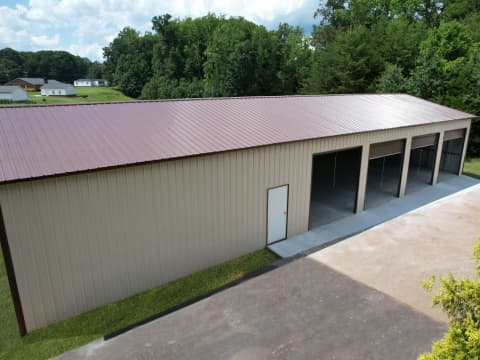
Suburban steel house
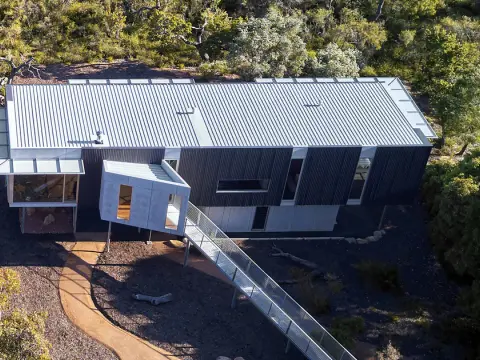
Steel plate houses in rainforest areas
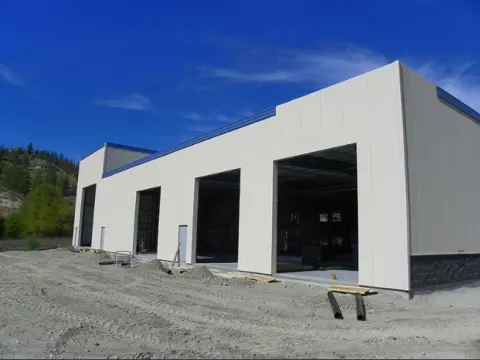
Steel plate houses in marine areas
| Code | Corrosion Degree | Indoor Environment | Outdoor Environment |
| C1 | Very Low | Dry and clean indoor environments, such as offices, schools, and museums. | Dry and cold regions, extremely low pollution, and low humid environments, such as deserts, the Arctic, and the Antarctic. |
| C2 | Low | Low-pollution and low-frequency condensation indoor environments, such as warehouses and stadiums. | Temperate zone and environments with low pollutant concentration (SO2≤5㎍/m3), such as villages and small towns; arid and cold regions and low humid environments, such as deserts and subarctic regions. |
| C3 | Medium | Sites with medium-frequency condensation and moderate pollution, such as food processing plants, laundry rooms, breweries, and dairy plants. | Temperate zone, medium pollutant concentration (5㎍/m3≤SO2≤30㎍/m3) or low-salinity atmospheric environment, such as cities, low-salinity coastal areas; subtropical and tropical areas, low-pollution environment. |
| C4 | High | Sites with high-frequency condensation and heavy pollution, such as industrial processing plants and swimming pools. | Temperate regions, high pollutant concentration (30㎍/m3≤SO2≤90㎍/m3) or high salinity environment, such as heavily polluted cities, industrial areas, moderate salinity coastal areas or areas exposed to deicing salt; Subtropical and tropical regions, moderately polluted environment. |
| C5 | Very High | Environments with extremely high-frequency condensation and heavy pollution, such as mines, industrial caves, and not-ventilated workshops in subtropical and tropical areas. | Temperate and subtropical regions with extremely high pollutant concentrations (90㎍/m3≤SO2≤250㎍/m3) or extremely high salinity, such as industrial areas, coastal areas, and coastal shelters. |
| CX | Extremely High | Sites with continuous condensation or exposed to high humidity and heavy pollution for a long time, such as not-ventilated workplaces where pollutants enter outdoors in humid tropics. | Subtropical and tropical, extremely high pollutant concentration (250㎍/m3≤SO2) and extremely high salinity environments, such as extreme industrial areas, coastal areas, offshore areas, etc. |
As shown in the table above, C1 and C2 belong to low-pollution environments, such as rural and light-polluted urban areas. It is recommended to use the color-coated steel with Z120-180 galvanized sheet or AZ80-100 galvalume sheet as the substrate. And PE paint with a thickness of 5+ 15/7 microns is enough.
C3 is a moderately polluted environment, such as heavily polluted cities, general industrial areas, and low-salinity coastal areas. It is better to choose HDP-coated or SMP-coated or PVDF-coated prepainted steel sheet with galvanized sheet (Z275 or more) or galvalume sheet (AZ150 or more) as substrates. The recommended paint thickness is 5+20/3+9 microns.
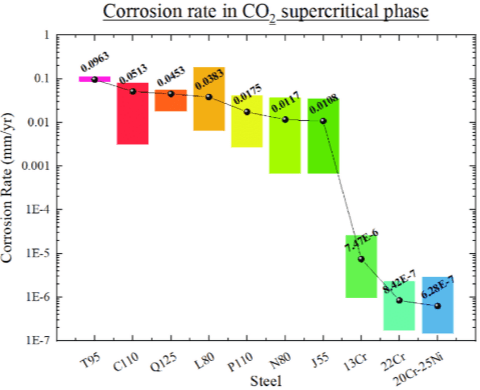
Corrosion rate of steel in different environments
The C4 level refers to heavily polluted industrial areas or medium salt spray seaside areas, or high-salt and high-humidity indoor environments, such as winemaking workshops, swimming pools, and seafood processing workshops. We suggest choosing AZ180 GL sheets as substrates, and HDP, SMP, or PVDF paints. The front paint thickness is 5+20 microns, and the back paint thickness is 3+9 microns.
C5 environments are very corrosive, such as high humidity, high corrosion industrial areas, high salinity seaside areas, pickling workshops, electroplating workshops, paper workshops, leather workshops, dyeing workshops, etc. It is recommended to use AZ220 or above aluzinc sheets as substrate and PVDF paints.
In addition, for areas with high altitudes and strong ultraviolet rays, it is not recommended to use PE coating.
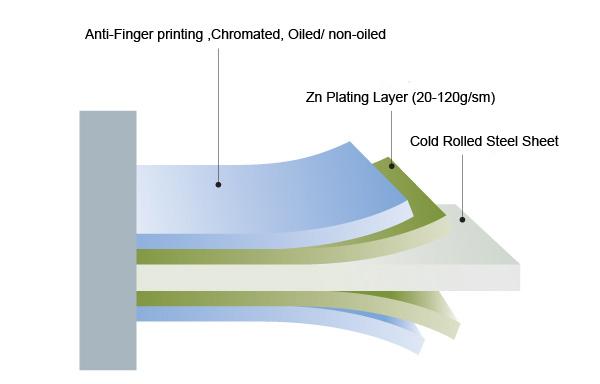
Galvanized steel coating structure
| Corrosion Degree | Zinc Coating Thickness | Al-Zn Coating Thickness | Paint Type | Paint Thickness (㎛) |
| C1 | ≧120g/m2 | ≧80g/m2 | PE | Top: 5+15 Back: 7 |
| C2 | ≧180g/m2 | ≧100g/m2 | PE | Top: 5+15 Back: 7 |
| C3 | ≧275g/m2 | ≧150g/m2 | HDP, SMP, PVDF | Top: 5+20 Back: 3+9 |
| C4 | – | ≧180g/m2 | HDP, SMP, PVDF | Top: 5+20 Back: 3+9/5+20 |
| C5 | – | ≧220g/m2 | PVDF | High thickness |
PPGI steel is an upgraded version of galvanized steel, with improved performance in various aspects such as service life, color, corrosion resistance, sunlight resistance, and decorative properties. Its structural mechanism is shown in the figure.
It is suitable for use in harsh environments such as high temperature and humidity, marine areas, industrial waste discharge areas, and high-standard medical areas.
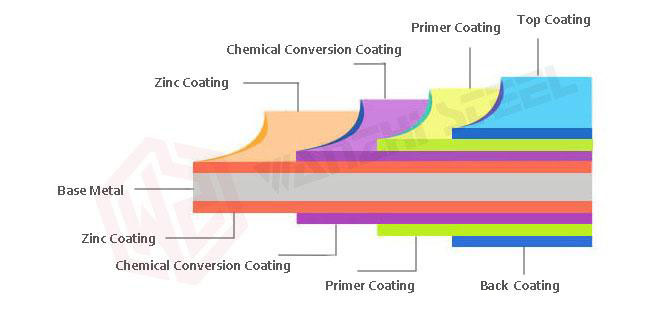
PPGI Steel Structure
For extremely corrosive environments, such as acid rain areas, polar regions, and applications in seawater…You can choose other materials such as stainless steel, ZAM steel, or color-coated aluminum sheet.
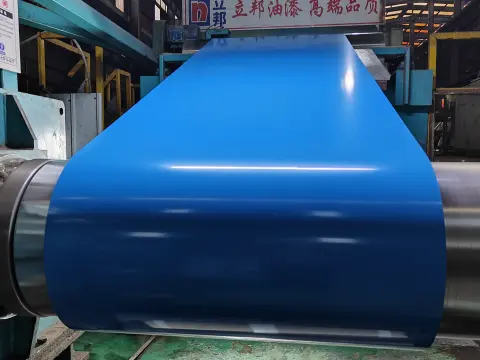
Blue color coated ppgi steel coil
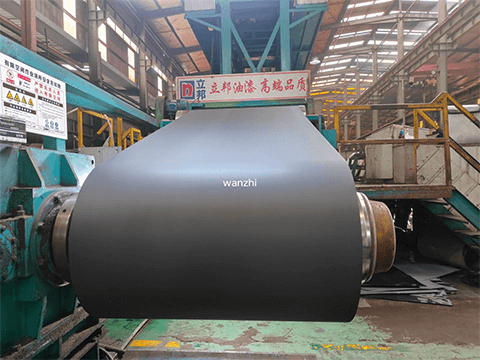
Dark grey DX51D PPGI coil
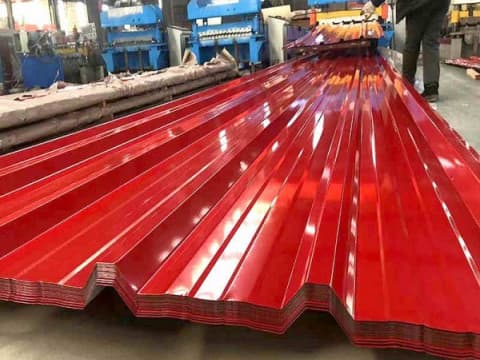
Corrugated Galvalume steel roof sheet
We supply color-coated steel coils and sheets in all colors, film thicknesses, widths, lengths, and shapes, including PPGI steel, PPGL steel, ZAM steel, stainless steel, and color-coated aluminum. Our products are ISO certified. With our high-quality products and services, we have exported our products to 120 countries around the world. If you are interested, welcome to contact us.





